
Most biology books have a chapter on macromolecules at the beginning, usually after the introduction to biology chapter. For freshman, this chapter can be challenging. They usually don’t have the background in chemistry to understand concepts like atomic structure and types of bonds.
The Miller and Levine Bee book also includes enzymes in this chapter. Enzymes can actually be fun! My students really like the hydrogen peroxide lab. I think it has something to do with the simple enjoyment of watching liver tissue bubble.
I added this worksheet to help them visualize how enzymes combine with substrates to make a product. It focuses on the lactose protein and the lactose enzyme. Students color the enzymes, the substrate, the products, and shade the active site.
This is also a good time to have a discussion about what it means to be “lactose intolerant.” Your students have probably heard of this before, or know someone that can’t drink milk.
The worksheet includes several statements that students complete. For example, “Enzymes bind with [ products | substrates ]. ” They complete the statement by highlighting or underlining the correct word.
The second page is a little more challenging. It shows a model of an anabolic enzyme that creates a disaccharide. If they have completing the chapter reading, they should be familiar with some of the terms. In this section, students describe what is happening in each step.
Other Activities on Enzymes
Analyzing Graphics – Enzymes – this is a more advanced version which also includes optimal temperature, pH, and inhibition
How Do Enzymes Work? – a simple laboratory investigation using liver and hydrogen peroxide (ideal for freshmen)
Enzyme Floating Disk Lab – advanced lab that explores how concentrations of enzymes affect reaction rates
Catalase Activity Using Sodium Alginate – create spheres with yeast and explore variables that rate of enzymatic reactions

